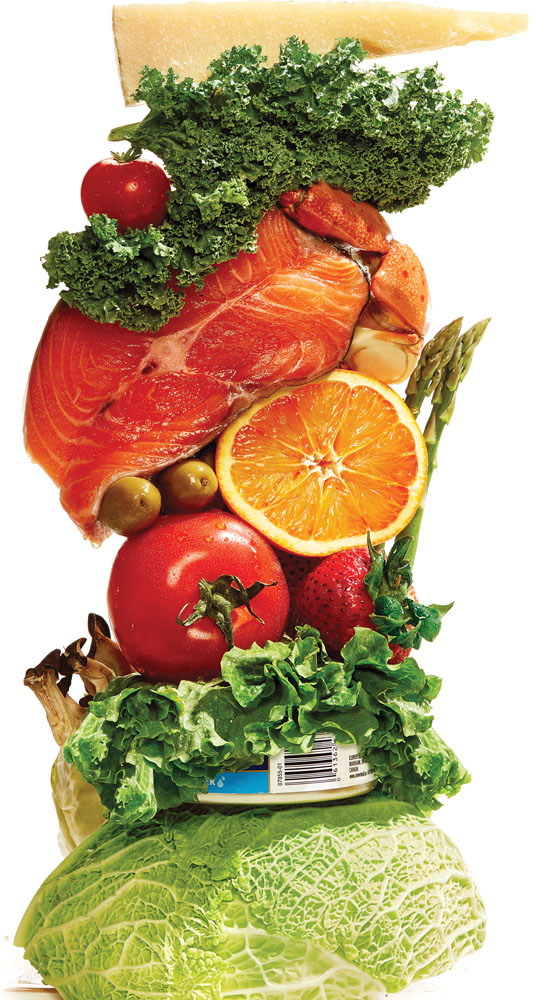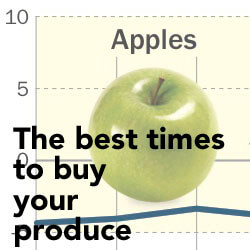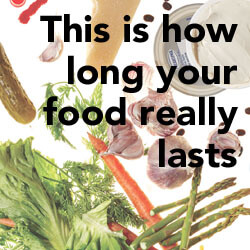Spend less, eat better
One man's quest to cut his grocery bill led him to save $1,500 a year
Advertisement
One man's quest to cut his grocery bill led him to save $1,500 a year

The complex where we lived until recently had only a single chute for waste. Several times a week, I would step into a pair of chewed up sneakers and make the 20-metre stroll to toss our garbage. As a family, we were diligent recyclers—cutting down boxes and bundling newspapers, which we still read—but we paid little attention to our kitchen waste. Bags filled with wrappers and plastic but also eggshells, old peppers and leftovers, were routinely pushed past the trap door and quickly forgotten.
When we moved to a new home earlier this year, our waste became harder to ignore. It now sits right outside our back door, laid bare to see. Thinking about it makes my stomach churn. Not so much the moist slop of decaying food scraps, but the value and volume of the food we carelessly throw away.
During one particularly bad stretch, my family threw out most of a carton of blueberries, a half rack of ribs, rice, baked potatoes and an unopened Costco-sized tray of chicken that had developed a pungent odour in our fridge when life interrupted our meal plans. That didn’t account for leftover scraps from our plates or the untouched dinner snubbed by an occasionally picky toddler who demanded cereal instead of roast chicken. I tallied it up: We tossed an estimated $40 worth of food in a week or so. Reading the wilting leaves in our green bin, I saw an opportunity to reduce our waste and lower our grocery bill.
I’m the resident shopper and chef in the family, so it’s mostly down to me. During weekly runs to the grocery store, I rarely bother with a list. We mostly pick up the same items each week: chicken, a couple tins of diced tomatoes, broccoli, asparagus, green beans. Our basket is consistent to the point where I can often guess the total before it gets rung through—typically $115 a week. That adds up to about $6,000 a year, for our family of four.
Apart from the sameness of our meals, this isn’t something we viewed a problem, until we tracked our waste and realized it was. In retrospect there have been too many occasions when the depths of our fridge decayed into a wasteland of half-used onions, liquefied cucumbers, petrified lemons and colourful penicillin colonies hiding half-eaten cheeses—all orphan ingredients from slapdash meals dreamed up on the fly.
We are not alone. At the University of Guelph, assistant professor Kate Parizeau was part of a research team that conducted an audit of residential food waste in the summer of 2014. They cracked open green bins to uncover the rotten truth about how much food is being tossed: The average family generated 4.5 kg of food waste every week. Of that, roughly 2.3 kg were avoidable, while another 0.5 kg were considered to be possibly avoidable. “We were picking up green bins that had been outside for between one and seven days and some of the food still looked pretty edible,” she says.
What’s equally shocking is the cost. According to research by Ralph Martin, the Loblaw Chair in Sustainable Food Production at the University of Guelph, that 4.5 kg of food is equal to about $28 every week or $1,465 a year. Given the average Canadian family of four spends roughly $140 a week on food that means about 20% of our grocery bills end up in the bin. It’s as much as many families spend annually on gas. “People are buying too much and not portioning well,” says Parizeau. “It adds up.”
Of course, inflation and the weakening loonie have also conspired to drive up supermarket bills, as have unusual price fluctuations, such as the one we saw earlier this year when the price of a single head of cauliflower jetted to $8 a head. By the end of 2016, food price increases are projected to outstrip the general inflation rate, which is alarming given how much of monthly spending is earmarked for food. The University of Guelph’s Food Institute expects the average household will spend $8,631 yearly on food, including $2,416 on restaurants. That’s up $345 from 2015, which was up $325 from 2014. That means the average family is spending $700 more on food than they were two years ago. Meats and vegetables are leading the way, up 4% and 9% respectively, and are projected to rise another 2.5% to 4.5% this year. So even if you avoid exorbitant cauliflowers (as I do), it won’t make you less immune to bill creep.
That is not welcome news. According to a recent poll by Vancouver-based Angus Reid Institute, 57% of Canadians say it’s becoming more of a challenge to put food on the table. Moreover, Canadians are cutting back in any way they can. Almost three out of four Canadians say they’ve switched to lower-priced house brands, while 61% have cut back on meat and 42% have cut back on fruits and vegetables. But do you really have to sacrifice nutrition or the foods you enjoy to save a buck?
I consulted a number of chefs, nutritionists and food experts and, over the course of six weeks, I experimented with the best advice they had to offer. My goal: to cut my $6,000 annual grocery bill by $1,500 or 25%, by reducing waste and shopping smarter. I refused to make any nutritional sacrifices whatsoever, and insisted on continuing to plate meals my family loves eating (because I don’t know about you but I’m not about to adopt a new habit if I don’t enjoy it). I found that with a bit of planning, not only can my family eat great for less, we can eat even better.
[brightcove video_id=”6023880336001″ account_id=”6015698167001″ player_id=”lYro6suIR”]While the average family wastes food like no tomorrow, a 2010 Canadian study found that well-run restaurants waste no more than 5%. I wanted to know what they are doing that I am not and set out to find someone who could appreciate the need to keep costs in check but still cook a kickass meal. My search led me to Suzanne Barr, the driving force behind Saturday Dinette, a modern 35-seat restaurant in Toronto’s trendy South Riverdale neighbourhood.
For Barr, watching costs comes second only to the care she puts into prepping brunch favourites like mushroom stout ragu on toast with lavender ricotta. “Being a true mom-and-pop restaurant, we do everything ourselves here and we watch every penny that goes in and out,” she says from behind the counter.
When Barr noticed that many plates were returning with an untouched buckwheat pancake during her highly touted weekend brunch service, she quickly dropped the serving size from three to two. “It’s almost like food coming out of our mouths and money coming out of our pockets,” she says of the uneaten food that ends up in the dish pit.
Adjusting portion sizes is something that works as well at home as it does at the restaurant. Author and registered dietician Cara Rosenbloom suggests that parents serve their kids smaller portions, offering seconds if they’re still hungry. After all, few people would pack up food that’s been picked over by a toddler, but with the right portioning, leftovers can be saved for another day.
Here’s another reason way restaurants keep their waste to a minimum: They use everything. “That’s how we really keep costs down, we use every part of the vegetable,” says Amanda Cohen, the Ottawa-born chef behind Dirt Candy, hailed by the New York Times as one of the most influential vegetarian restaurants in the United States. “We find uses for them even if they are going bad; we will pickle them or dehydrate them.”
Barr operates the same way. When she gets her order of fennel she mixes it into her slaw, uses the fronds for fennel butter and incorporates the rest into three different cooking stocks she makes. “It’s about getting the most out of every single thing here,” she says.
And if the foods can’t be incorporated on the plate right away, you still have options that don’t require dusting off your grandparent’s canning equipment. “Take a loaf of bread and turn it into bread crumbs,” suggests Barr. “Challenge yourself to make something you’ve never made before.”
Adjusting portion sizes and getting creative can help you use up stray ingredients, but it only gets you so far. Overbuying is the elephant in the refrigerator. This is a particular problem in North America where many of us take pride in our ability to snap up perceived deals by buying in bulk. All those four-litre buckets of ketchup and pickles, intended to save money, more often end up creating more waste.
A 2010 University of Arizona study looked at shoppers who stocked up on food at low-priced retailers like Walmart and Costco and found that they rarely consider the cost of what they end up discarding. In one case a participant who bought salad greens at Costco for “$3.50 or something” ended up discarding a large portion, but still felt it was a better deal than buying a more reasonably-sized container of greens for $2.50. “The modern American tendency to shop infrequently is at odds with basic human abilities to predict future food consumption needs,” was the author’s conclusion.
It comes down to knowing what you are able to consume, says Sylvain Charlebois, professor of business and economics at the University of Guelph. “We are bad inventory managers at home,” he says. “We live fast-paced lives and at times the food we buy and what happens at home gets the best of us.”
Buying perishables in bulk makes the least sense since they’re the first things that get tossed when we realize we’re too tired to cook one night. But the issue goes beyond stockpiling foods that go off. A 2000 report out of the University of Illinois, aptly titled “Cabinet Castaways,” warned of the risk of products bought for a specific recipe or occasion that never arose. It suggests that as much as 15% of our non-perishable goods are never used and eventually get tossed after gathering dust in our pantries.
Likewise, North Americans have grown accustomed to filling their fridges with so much stuff we struggle to find room for milk. I’m guilty of this. My freezer is packed with bags of ice-encrusted meats, some of which have been with us since we left the condo. Without even seeing my freezer, this frustrates Chef Barr. “What’s in there? Things in your freezer shouldn’t be there more than a month. If it’s there after a month are you really ever going to eat it?” Her rule: Open your freezer as often as you open your fridge and make sure things are coming out as often as they’re going in. Otherwise, “yeah, that freezer is going to continue to grow and grow.”
The simplest way to fight the compulsion to stockpile food: Shop more often and for less stuff.
Dirt Candy’s Amanda Cohen is a proponent of this idea. Until recently, Cohen operated out of an 18-seat restaurant where keeping costs in check was a matter of survival. “We bought our vegetables every single day. We never had leftovers at the end of the night. We always started fresh,” she says. “It really meant we were using what we were buying and that stuck with us at the new place.”
She says that if you can’t predict more than a few days in advance, then chances are you’re buying food you have no intention of eating. “It’s better to shop twice a week than to shop once and have a whole fridge of food go bad,” says Cohen. “It’s OK to run out.”
This sounded like a logistical nightmare to me. On my first attempt, I went halfway: We did our weekly shopping trip but only bought what we needed to get us through the weekend, and then replenished throughout the week. If we got stuck, I knew we had some meat in the freezer we could chip out from under the ice. To my surprise, the bill rang up to a mere $40. The additional mid-week trip, for fresh vegetables, only added another $10 or so. In terms of food costs we saved $65 off our weekly bill—granted I managed to avoid meat purchases, but that would only add $30 or so for the week, which still put us 20% below our typical bill. If figured that if we did this once or more a month, we’d shave nearly $1,000 a year from our supermarket spending.
By the same token don’t feel compelled to spend extra on organic carrots. Amanda Cohen’s whole business is built on turning common vegetables into high art and she doesn’t. She happily admits she’s seasonal agnostic and has never gone out of the way to buy top-of-the-line fruits and vegetables. She prefers to work with the same produce most of us have in our home kitchens.
Cohen feels consumers get too caught up in the notion of buying locally and in-season. While Cohen says it’s great to support local farmers, the reality is most of our food comes from other parts of the globe. “Oranges are always out of season in Canada,” she offers by way of an example, adding that there’s nothing wrong with that. In a widely read New York Times column, she noted how little most grocery stores stock in the way of local foods. “The fact is, we live in a post-seasonal world,” she wrote. “The vast majority of our fruits and vegetables comes to us on trucks and planes from faraway farms, and everything is always in season somewhere. Make your peace with it.”

Still I instinctively thought certain foods would be cheapest during the months they’re grown in abundance. After all, it’s when they are freshest and most plentiful. But a detailed study of the Canadian consumer price index, which measures changes in the prices Canadians experience for a fixed basket of goods, revealed otherwise. Going back over 20 years of data, I noticed some interesting patterns emerge. Citrus is cheapest during the first three months of the year, while apples are most expensive during August and September, just when they’re coming into season in Ontario. According to Kelly Ciceran, general manager with Ontario Apple Growers, that’s because demand actually outstrips supply during those months. The cheapest apples arrive in stores in January. “That’s when there are lots of promotions, both from us and our competition,” says Ciceran. “We typically sell more bagged apples at this time which can be less expensive than loose apples.”
Meanwhile, you can save by buying oddly shaped fruit and vegetables at any time. Loblaws latched onto this idea last year when it launched its Naturally Imperfect line of produce, selling undersized, discoloured or misshaped onions, apples, carrots and mushrooms for up to 30% less than their runway-ready counterparts. Nutritionally and taste-wise there is no difference.
You’ve probably heard the old adage that you should shop the periphery of the store, where you find most of the fresh and perishable products, and skip the middle aisles. Nutritionist after nutritionist I spoke with urged me to take a turn down the freezer aisle, for my wallet and my health. “There are studies that show these products are just as fresh,” says Rosenbloom. In some ways, they’re even better. “Often the frozen ones have a higher nutrient content,” she explains. Think about how most produce gets to the store in the first place. It’s had a long journey and nutrients and vitamins like vitamin C break down over time. A bunch of fresh spinach could have spent a week or more in transit. Frozen produce is typically flash frozen within six to 12 hours of being picked when it’s at its peak freshness, she says.

Following Rosenberg’s advice, I picked up a two-kg bag of frozen broccoli from Costco for $10. A bit of math suggested it contained about 20 servings. And while I wondered what Chef Barr would say, I felt slightly better when, a few days later, I noticed a single stock of limp broccoli, enough for two servings, selling for $2 at my local supermarket.
In this case, frozen offered a significant savings—$10 in this scenario—over buying fresh. Using the freezer aisle as a hedge when fresh produce costs are high, or to have on hand during weeks when you don’t know if you’ll have time to cook, will cut my food waste and ultimately help lower my grocery bill. But beware that not every frozen food item is always a deal. Breaking out the calculator, I learned that strawberries are almost always a better deal fresh. It’s only after they top $4.99 per pound that it pays to buy frozen.
I’m confident that I made a wise decision with my bag of broccoli—so long as I don’t forget it’s there. It shouldn’t be a problem: It takes up half the space in my freezer.
Here’s an all too common ritual: You reach into your fridge and grab a yogurt, only to notice it was “best before” yesterday. So you toss it out. At the University of Guelph, associate professor Mike von Massow argues that our fixation on these dates is misplaced. The dates printed on packages are really “sell-by” dates, when the food is at peak freshness, he explains. The food is still good, just not ideal for sale. It really comes down to a judgment call, he says, noting we’re often too quick to dispose of leftovers. “If it’s cooked properly,” he says, “you are starting with a clean slate.” If it smells fine, probably is fine. 
I find there’s a bit of a “yuck” factor with this advice. I still have nightmares of a teenage encounter with a commercial-sized vat of OJ well past its expiration date. As such, I view expiration dates the same way I’d approach a bomb ticking down: I don’t want them to be around when they go off. For the paranoid like me, sites like Stilltasty.com can tell you everything from how long you can keep that open jar of salsa (one month) and how long you can freeze maple syrup (indefinitely) to how long that tub of yogurt should last past its sell-by date (seven to 10 days, apparently). The key is to manage your stock wisely. That means employing proper food storage and resisting the urge to crack open a fresh tub of sour cream just because the other one has already been open a few days.
The freezer aisle isn’t the only one consumers should hit; don’t forget the candy aisle, says Rosenbloom. Not because she wants to see consumers load up on jujubes, but because that’s where many grocers typically stock pulses—beans, lentils and seeds—which can be used to help bulk up dishes so you can use less meat. Beef in particular is one of the grocery groups that has risen the most in recent years—with the price of a sirloin steak rising by more than 15% since 2014, according to Statistics Canada.
About two cups of cooked red lentils is all I can handle. Following Rosenbloom’s advice, I added a handful to a batch of sloppy joes, as well as to a meatloaf, and still had plenty of the cooked lentils leftover. I was pleased to see it stretched our ground beef by adding at least two extra meals, even if the recipe had room for improvement. (My sloppy joes look more like chili.)
Each of those meals would have cost $1.73 per person in meat alone, but bulking up with lentils dropped the protein cost to $1.03—a 40% savings. I don’t think I could keep all of our meal prices down this much, but if I did we would save $700 a year. Not a bad return for a $6 bag of lentils.
Tofu is another food that can put a serious dent into your grocery bill, and a great substitute for recipes that call for boneless chicken breast. “For $2.99 you can feed a family of four,” says Rosenbloom. Up for the challenge I decided to take her advice a step further by combining it with another piece of advice Barr gave me when I visited her at the diner. Barr’s tip? Whether it’s meat or vegetable, utilize an ingredient in a number of ways to get the most out of it. For instance, she has beets on her menu three times. “People would never guess that it’s used in so many dishes.”

At home that meant adding bean curd to our menu for two straight days. As someone who eats meat three times a day, a meal of tofu sounded about as enticing as a plate of boiled brussels sprouts to a teen. But following some advice I cubed up some extra-firm tofu and tossed it into some caramelized butter in a sizzling frying pan. It took only minutes to throw together a simple stir fry, but it was surprisingly good and filling. A similar meal using chicken would have cost upwards of $9 in meat costs alone; this cost less than $3, and there was more than enough left over for lunch. Tofu Thursdays is now a meal we look forward to, and we used the leftover protein for a brown fried rice experiment the next day which resulted in another successful side dish.
Meats add a lot of weight to a grocery bill. Even if you don’t want to explore vegetarian options, there are other things you can do to lower this portion of your bill. Consider buying bone-in, skin-on chicken, suggests Zannat Reza, a registered dietician and founder of the food consultancy Thrive360. You can always de-bone it at home or cook it as is, she says. With boneless, you’re paying extra for convenience.
For similar reasons Reza suggests skipping lean or extra lean beef and draining the fat. “Sometimes it can be half the price,” she says. “Obviously if you are making a recipe where you can’t drain off the excess grease then go for the lean, but with a stir fry it’s no problem.” And just as with chicken, medium ground beef packs a ton of flavour.
Just as there are thousands of ways to prepare a plate of spaghetti, there are many ways to reduce your grocery bill and trim your waste. But my goal was to disrupt my own routine to find where I was wasting money. It was a challenge, but not nearly as difficult as I feared. Integrating the tips collected from Chef Barr and others into my daily routine wasn’t overly tiresome and well worth the effort. By my calculations, they have the potential to save me as much as $1,500 over the course of the year. It’s true that few households will ever be as smoothly and efficiently run as a restaurant. I for one have no plans to make homemade stock from my chicken bones and vegetable ends. Those will always end up in my green bin. But even if you only adopt a few of these tricks at home or at the grocery store, you’ll start to notice modest savings. As Barr explains, it’s all about how you utilize the products when you first pick them up. She stresses that you have to be realistic with yourself: “Am I really going to use this or should I just buy a little less?” Who knows, you might save enough to justify grilling up a few extra rib-eyes this summer.
Share this article Share on Facebook Share on Twitter Share on Linkedin Share on Reddit Share on Email